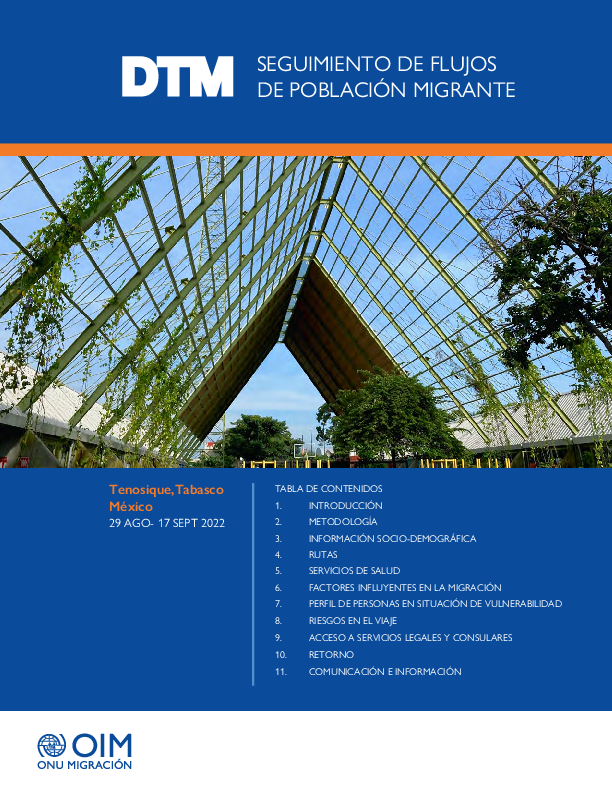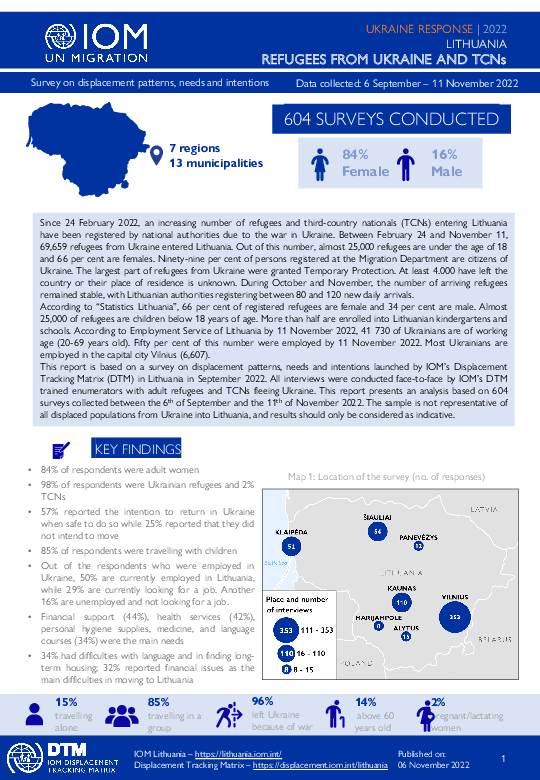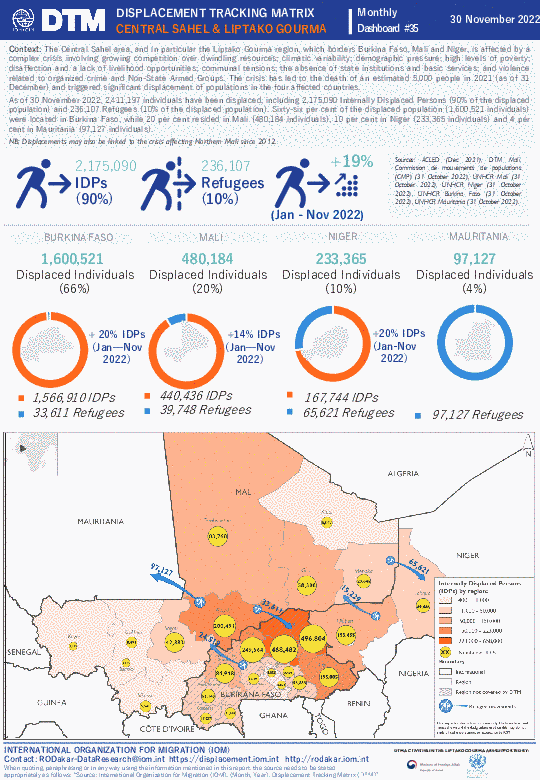-
Countries
-
Data and Analysis
-
Special Focus
-
Crisis Responses
The crisis currently affecting the Lake Chad Basin states results from a complex combination of factors, including conflict with Non-State Armed Groups, extreme poverty, underdevelopment and a changing climate, which together have triggered significant displacement of populations. As of 30 November 2022, Cameroon, Chad, Niger and Nigeria were hosting an estimated 6,034,686 affected individuals made up of Internally Displaced Persons (IDPs), Refugees (both in- and out-of-camp) and Returnees (Former IDPs and Returnees from abroad). 73 per cent of the affected population (representing 4,427,934 individuals) were located in Nigeria, while 11 per cent resided in Cameroon (654,136) individuals), 8 per cent in Chad (505,928 individuals) and 7 per cent in Niger (446,687 individuals).
La région du Sahel central, et plus particulièrement la zone du Liptako Gourma, qui enjambe le Burkina Faso, le Mali et le Niger, est témoin d’une crise complexe qui comprend comme enjeux une compétition grandissante pour le contrôle de ressources; des bouleversements climatiques; une croissance démographique galopante; des niveaux élevés de pauvreté; l’absence d’opportunités économiques et un sentiment de désillusions quant au futur; des tensions communautaires; l’absence de présence étatique et le manque de services sociaux de base; et des violences provoquées par des réseaux de crime organisé et des groupes armés non étatiques. La crise a engendré, en 2021, la mort de 5 000 personnes (au 31 décembre) et conduit à des déplacements de populations significatifs dans les quatre pays touchés par la crise.
Au30 Novembre 2022, 2 411 197 individus étaient déplacés par la crise, y compris 2 175 090 Personnes déplacées internes (90% de la population affectée) et 236 107 réfugiés (10%). Soixante-six pour cent de la population déplacée (1 600 521 personnes) se trouvait au Burkina Faso, 20 pour cent au Mali (480 184), 10 pour cent au Niger (232 770) et 4 pour cent en Mauritanie (97 127).
The Central Sahel area, and in particular the Liptako Gourma region, which borders Burkina Faso, Mali and Niger, is affected by a complex crisis involving growing competition over dwindling resources; climatic variability; demographic pressure; high levels of poverty; disaffection and a lack of livelihood opportunities; communal tensions; the absence of state institutions and basic services; and violence related to organized crime and Non-State Armed Groups. The crisis has led to the death of an estimated 5,000 people in 2021 (as of 31 December) and triggered significant displacement of populations in the four affected countries.
As of 30 November 2022, 2,411,197 individuals have been displaced, including 2,175,090 Internally Displaced Persons (90% of the displaced population) and 236,107 Refugees (10% of the displaced population). Sixty-six per cent of the displaced population (1,600,521 individuals) were located in Burkina Faso, while 20 per cent resided in Mali (480,184 individuals), 10 per cent in Niger (233,365 individuals) and 4 per cent in Mauritania (97,127 individuals).
La République centrafricaine (RCA) souffre d’instabilité sécuritaire, politique et économique depuis deux décennies. La dernière crise atteignant le pays a débuté en 2012, suite à une prise du pouvoir violente, et a depuis évolué en un état d’insécurité et de fragilité permanent, découlant d’une crise complexe de long-terme qui s’est étendue dans les pays voisins. La crise a conduit au décès de 826 personnes en 2022 (au 28 Novembre) et a déclenché des déplacements massifs de populations dans les sept pays touchés par la crise. Cette dernière est caractérisée par des rivalités pour le pouvoir parmi les élites du pays, l’absence d’institutions étatiques et d’investissement d’argent public, des tensions inter-ethniques et inter-religieuses et la lutte pour le contrôle de ressources.
Au 28 Novembre 2022, 3 578 469 individus étaient déplacés, dont 505 059 Personnes déplacées internes (14% de la population déplacée), 1 880 785 Retournés (anciennes PDI) (53%), 446 625 Retournés de l’étranger (12%) et 746 000 Réfugiés dans les pays limitrophes (21%). En RCA, les Retournés anciennes PDI représentent la plus grande population affectée (66%), tandis que les PDI représentent 18 pour cent de la population atteinte dans le pays et les Retournés de l’étranger 16 pour cent de la population déplacée présente dans le pays. Les réfugiés centrafricains résident principalement au Cameroun (353 362 individus, soit 47% des réfugiés), la République démocratique du Congo (212 120 individus, soit 28% des réfugiés) et au Tchad (124 491 individus, soit 17% des réfugiés).
The Central African Republic, which has experienced continuous volatility for the past two decades, has been riddled by a crisis which ignited in 2012 with a violent takeover of power and has developed into a complex protracted state of permanent insecurity and fragility which has spilled over into neighbouring countries. The crisis has led to the death of an estimated 826 people in 2022 (as of 28 November) and triggered significant displacement of populations in the seven affected countries. The crisis is characterized by power struggles amongst elites, the absence of state institutions and public investment, religious and ethnic tensions and disputes for the control of key resources.
As of 28 November 2022, 3,578,469 individuals were displaced, including 505,059 Internally Displaced Persons (14% of the displaced population), 1,880,785 Returnees (former IDPs) (53%), 446,625 Returnees from abroad (12%) and 746,000 Refugees in neighbouring countries (21%). In the Central African Republic, the largest displaced population consists of Former IDP Returnees (66%), while IDPs represent 18 per cent of the displaced population present in the country and Returnees from abroad represent 16 per cent of in-country displaced people. Refugees from the Central African Republic are primarily hosted by Cameroon (353,362 individuals, or 47% of refugees), the Democratic Republic of the Congo (212,120 individuals, or 28% of refugees) and Chad (124,491 individuals, or 17% of refugees).

Contact
DTM Burundi, DTMBurundi@iom.int
Language
French
Location
Burundi
Period Covered
Nov 28 2022
Dec 03 2022
Activity
- Mobility Tracking
- Event Tracking
Entre le 28 novembre au 3 décembre 2022, la DTM a identifié 15 659 personnes affectées dont 315 personnes déplacées par les pluies torrentielles, des vents violents et la grêle.
Contact
DTM Burundi, DTMBurundi@iom.int
Location
Burundi
Activity
- Mobility Tracking
- Event Tracking
Period Covered
Nov 28 2022 -Dec 03 2022
Activated on an ad hoc basis, the DTM Emergency Tracking provides early field reports at the beginning of a complex crisis, allowing IOM to gather, consolidate and disseminate baseline information on displacement and return figures at the onset of a newly emerging crisis. The DTM Emergency Tracking relies heavily on information provided by RARTs or partners within the humanitarian community about an unfolding situation. The Emergency Tracking gathers data through IOM Burundi’s extended network of key informants, who provide basic information on the new displacement, be it of IDPs or returnees, or both, including numbers, location and shelter types. While IOM DTM strives to provide best estimates, the Emergency Tracking aims to be a quick monitoring tool with real-time data turnover ranging from 24 to 72 hours following its activation.
Population Groups
Survey Methodology
Unit of Analysis Or Observation
Type of Survey or Assessment
Keywords
Geographical Scope
Administrative boundaries with available data
The current dataset covers the following administrative boundaries

Contact
DTM México, iommexicodtm@iom.int
Language
Spanish
Location
Mexico
Period Covered
Aug 29 2022
Sep 17 2022
Activity
- Flow Monitoring
- Event Tracking
El presente reporte es resultado de un trabajo de compilación de información en terreno entre 29 agosto -17 septiembre 2022. Se realizó un monitoreo sobre la presencia de personas migrantes en las ciudades de Tenosique (Tabasco) con el objetivo de conocer sus principales características sociodemográficas, sus necesidades y vulnerabilidades para contar con información útil, confiable y actualizada de modo que las contrapartes en terreno que brindan atención a la población migrante puedan tomar decisiones sobre la gobernanza migratoria basadas en datos confiables y actualizados.
Tenosique es una de las ciudades con mayor afluencia de personas migrantes en la zona fronteriza del sur de México. Adicionalmente, la presencia de instituciones y organizaciones dedicadas a la migración convierte a Tapachula en un polo de atracción para la población migrante que requiere algún tipo de atención y/o información migratoria.

Contact
DTM México, iommexicodtm@iom.int
Language
Spanish
Location
Mexico
Period Covered
Aug 29 2022
Sep 17 2022
Activity
- Flow Monitoring
- Event Tracking
El presente reporte es resultado de un trabajo de compilación de información en terreno entre 29 agosto -17 septiembre 2022. Se realizó un monitoreo sobre la presencia de personas migrantes en las ciudades de Tapachula (Chiapas) con el objetivo de conocer sus principales características sociodemográficas, sus necesidades y vulnerabilidades para contar con información útil, confiable y actualizada de modo que las contrapartes en terreno que brindan atención a la población migrante puedan tomar decisiones sobre la gobernanza migratoria basadas en datos confiables y actualizados.
Tapachula es una de las ciudades con mayor afluencia de personas migrantes en la zona fronteriza del sur de México. Adicionalmente, la presencia de instituciones y organizaciones dedicadas a la migración convierte a Tapachula en un polo de atracción para la población migrante que requiere algún tipo de atención y/o información migratoria.

Contact
DTM Europe, DTMMediterranean@iom.int
Language
English
Location
Lithuania
Period Covered
Sep 06 2022
Nov 11 2022
Activity
- Survey
- Flow Monitoring
Since 24 February 2022, an increasing number of refugees and third-country nationals (TCNs) entering Lithuania have been registered by national authorities due to the war in Ukraine. Between February 24 and November 11, 69,659 refugees from Ukraine entered Lithuania. Out of this number, almost 25,000 refugees are under the age of 18 and 66 per cent are females. Ninety-nine per cent of persons registered at the Migration Department are citizens of Ukraine. The largest part of refugees from Ukraine were granted Temporary Protection. At least 4,000 have left the country or their place of residence is unknown. During October and November, the number of arriving refugees remained stable, with Lithuanian authorities registering between 80 and 120 new daily arrivals.





